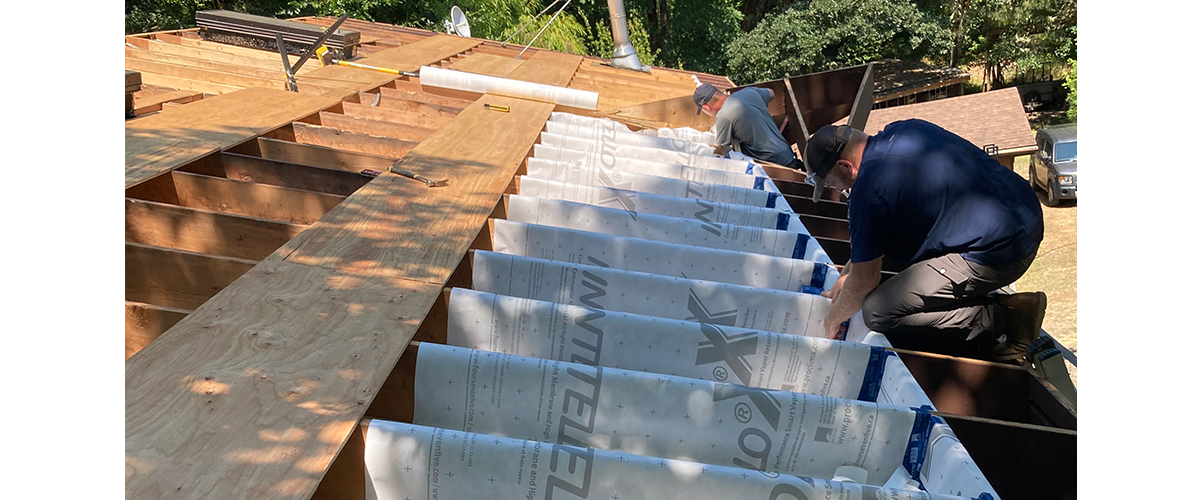Leaving Interior Finish Intact
On a winter morning in Corvallis, Oregon, homeowner Debbie Palmer noticed a new stain on the carpet and realized the roof had serious condensation issues - stained black water was dripping from the ceiling.
“When a contractor cut a hole through to install bath vents last winter, everything was so sodden he could literally squeeze water out of the insulation”, said Debbie.
This solid cedar log home built in 1984 with beautiful existing cedar tongue & groove ceilings that they wanted to keep intact, but the roof assembly needed a fresh new layer of insulation with proper vapor control, airtightness, and waterproofing.
Interior Air Barrier + Thermal Control
Debbie worked with Dan Dodson of D&E Construction and they removed all of the existing shingles and roof sheathing to expose the rafters and interior cedar finish below. They had originally planned on spray-foaming the roof, but were concerned about the cost, toxicity, and durability. Debbie found out about Havelock Wool insulation, a natural sheep wool product. Havelock suggested they use Pro Clima membranes for their water protection, airtight, and vapor control layers. After they demo’d from the exterior the first step was providing interior vapor control and airtightness. For this they installed INTELLO X membrane. This membrane is watertight, airtight, and vapor variable. The INTELLO needs the majority of the insulation outboard for the vapor variable control to work in their favor. So the project team pinched the INTELLO X membrane around the existing rafters and then ran it across the exterior side of the cedar finish, creating cavity bays for fibrous vapor-permeable batt insulation to be installed. The team used 2 layers of Havelock sheep wool batt insulation to reach desired R-value.
Exterior Air Sealing and Waterproofing
After the primary air barrier / vapor control layer (INTELLO X) was installed along with the insulation, the project team then installed a SOLITEX MENTO membrane to act as the waterproofing membrane for the roof. This membrane is airtight and vapor open, allowing the assembly to dry through diffusion to the exterior. The SOLITEX MENTO membrane seams were taped with TESCON VANA tape.
Roof Venting
After the SOLITEX MENTO membrane was installed the project team created a vented drainage plane outboard of the SOLITEX MENTO membrane. This drainage plane allows moisture that diffuses through the SOLITEX MENTO to shed away from the building and is deep enough to allow venting (air movement) which also promotes drying. TESCON NAIDECK is a double-sided tape for waterproofing where the roof battens’ fasteners penetrate the SOLITEX MENTO membrane.
Shingle Install
After the roof is waterproofed and vented the project team then installed another layer of sheathing. This additional layer of sheathing is not necessary from a building science standpoint, but it’s giving a substrate for a new asphalt shingle roof finish and eases prescriptive code approval since the roof is ventilated below this additional layer of sheathing. This additional layer of sheathing is waterproofed with a vapor retarding membrane and the sheathing is held from the roof peak to allow venting.
Further Resources
This project is a prime example of our Wood Frame Retrofit Smart Enclosure details in practice. The 475 Smart Enclosure ebook series show best practice assembly options for a variety of construction types, both retrofit and new construction. Click the "DOWNLOAD SMART ENCLOSURE DETAILS" button below to receive these resource for free in your email. To find out more about vented roof assemblies with SOLITEX MENTO please see A High Performance Roof Should Be Vented. Or for unvented roof assemblies with INTELLO please check out Yes, Unvented Roof Assemblies Can Be Insulated With Fiberglass.



 Interior Cedar Finish
Interior Cedar Finish
 Mystery liquid drips down roof beam
Mystery liquid drips down roof beam
 Old Shingle Roof
Old Shingle Roof
 Intello X membrane pinching around rafters from above
Intello X membrane pinching around rafters from above
 The Intello X membrane also wrapped around the rafter blocking and plywood sheets were used as the walking surface for the Intello install
The Intello X membrane also wrapped around the rafter blocking and plywood sheets were used as the walking surface for the Intello install

 TESCON VANA tape used to tape the INTELLO X seams
TESCON VANA tape used to tape the INTELLO X seams
 Batts of Havelock Sheeps’ Wool being installed above the INTELLO X membrane
Batts of Havelock Sheeps’ Wool being installed above the INTELLO X membrane
 Batts of Havelock Sheeps’ Wool being installed above the INTELLO X membrane
Batts of Havelock Sheeps’ Wool being installed above the INTELLO X membrane
 TESCON VANA tape used to tape the INTELLO X seams
TESCON VANA tape used to tape the INTELLO X seams
 First run of SOLITEX MENTO installed at the eave so the membrane overlaps to promote drainage
First run of SOLITEX MENTO installed at the eave so the membrane overlaps to promote drainage

 SOLITEX MENTO seams are taped with TESCON VANA
SOLITEX MENTO seams are taped with TESCON VANA
 SOLITEX MENTO edges are taped with TESCON VANA
SOLITEX MENTO edges are taped with TESCON VANA
 Double-sided black tape TESCON NAIDECK used between roof battens and SOLITEX MENTO membrane to waterproof fastener penetrations
Double-sided black tape TESCON NAIDECK used between roof battens and SOLITEX MENTO membrane to waterproof fastener penetrations
 Drainage plane and venting above the SOLITEX MENTO membrane
Drainage plane and venting above the SOLITEX MENTO membrane
 The battens stop just short of the ridge because a ridge cap will be installed to allow venting at the peak of the roof
The battens stop just short of the ridge because a ridge cap will be installed to allow venting at the peak of the roof
 Additional layer of sheathing being installed
Additional layer of sheathing being installed
 New Asphalt Shingle Roof installed
New Asphalt Shingle Roof installed
 Vents for the roof located at the eaves of the building
Vents for the roof located at the eaves of the building
